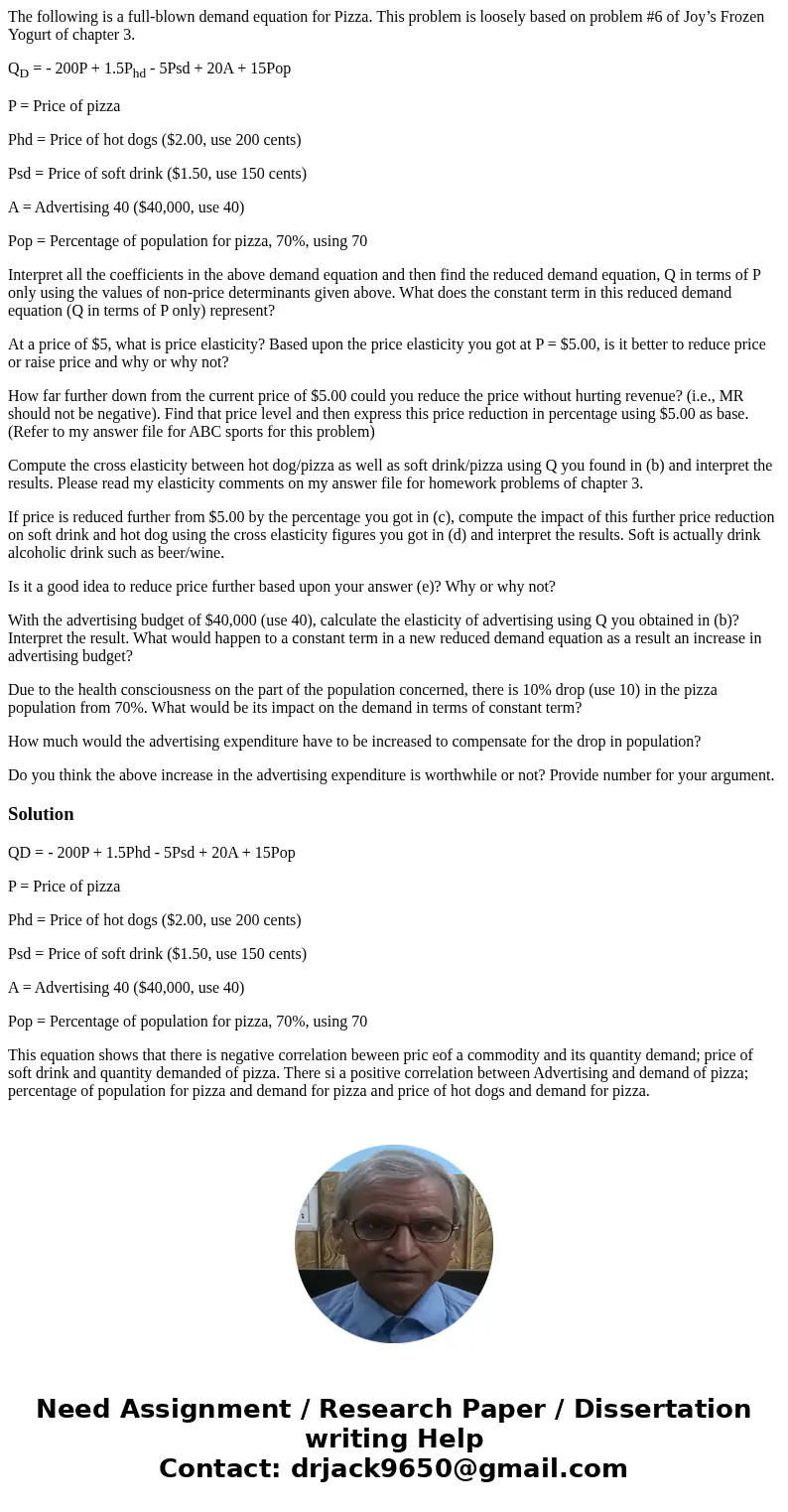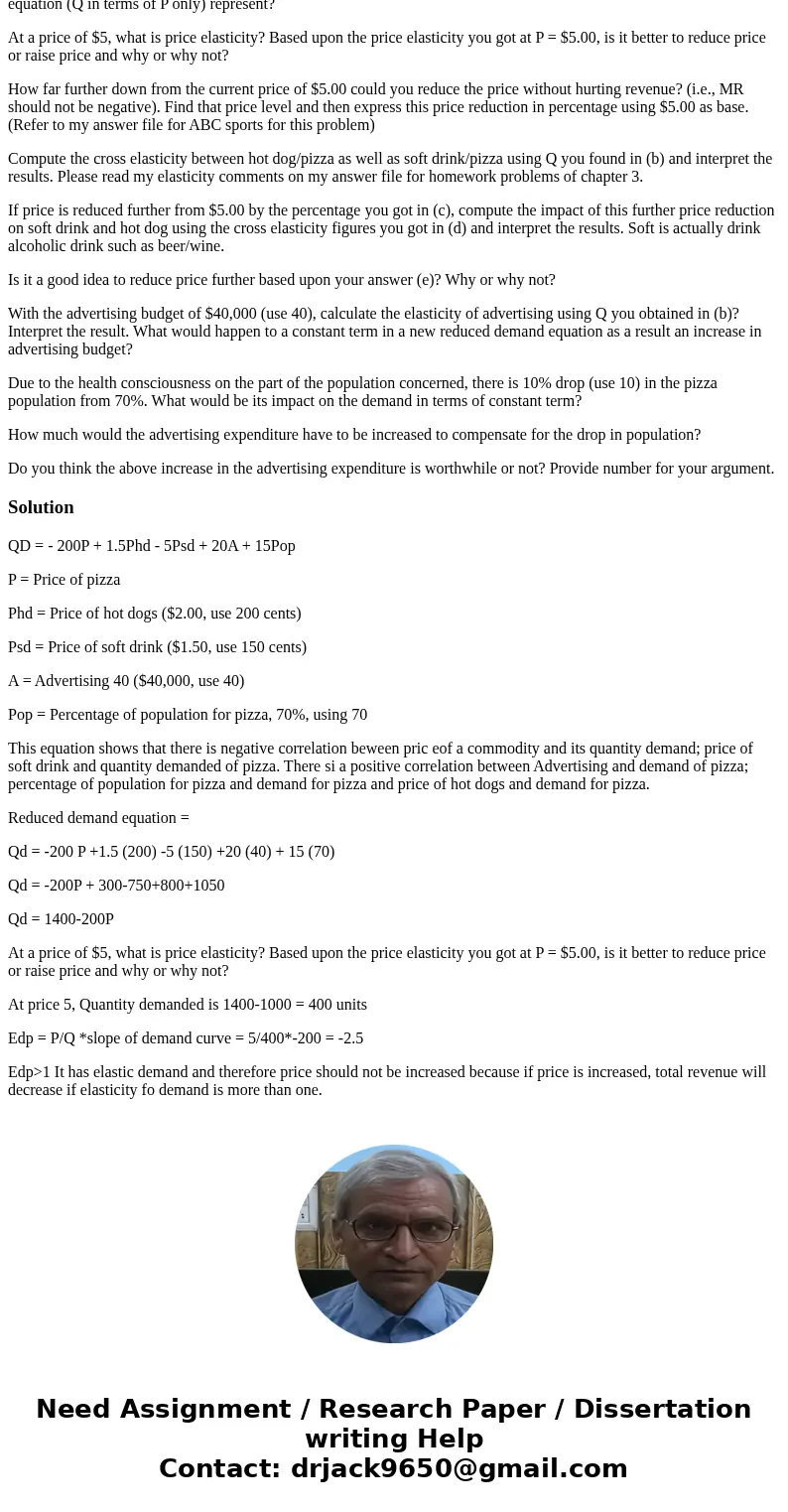The following is a fullblown demand equation for Pizza This
The following is a full-blown demand equation for Pizza. This problem is loosely based on problem #6 of Joy’s Frozen Yogurt of chapter 3.
QD = - 200P + 1.5Phd - 5Psd + 20A + 15Pop
P = Price of pizza
Phd = Price of hot dogs ($2.00, use 200 cents)
Psd = Price of soft drink ($1.50, use 150 cents)
A = Advertising 40 ($40,000, use 40)
Pop = Percentage of population for pizza, 70%, using 70
Interpret all the coefficients in the above demand equation and then find the reduced demand equation, Q in terms of P only using the values of non-price determinants given above. What does the constant term in this reduced demand equation (Q in terms of P only) represent?
At a price of $5, what is price elasticity? Based upon the price elasticity you got at P = $5.00, is it better to reduce price or raise price and why or why not?
How far further down from the current price of $5.00 could you reduce the price without hurting revenue? (i.e., MR should not be negative). Find that price level and then express this price reduction in percentage using $5.00 as base. (Refer to my answer file for ABC sports for this problem)
Compute the cross elasticity between hot dog/pizza as well as soft drink/pizza using Q you found in (b) and interpret the results. Please read my elasticity comments on my answer file for homework problems of chapter 3.
If price is reduced further from $5.00 by the percentage you got in (c), compute the impact of this further price reduction on soft drink and hot dog using the cross elasticity figures you got in (d) and interpret the results. Soft is actually drink alcoholic drink such as beer/wine.
Is it a good idea to reduce price further based upon your answer (e)? Why or why not?
With the advertising budget of $40,000 (use 40), calculate the elasticity of advertising using Q you obtained in (b)? Interpret the result. What would happen to a constant term in a new reduced demand equation as a result an increase in advertising budget?
Due to the health consciousness on the part of the population concerned, there is 10% drop (use 10) in the pizza population from 70%. What would be its impact on the demand in terms of constant term?
How much would the advertising expenditure have to be increased to compensate for the drop in population?
Do you think the above increase in the advertising expenditure is worthwhile or not? Provide number for your argument.
Solution
QD = - 200P + 1.5Phd - 5Psd + 20A + 15Pop
P = Price of pizza
Phd = Price of hot dogs ($2.00, use 200 cents)
Psd = Price of soft drink ($1.50, use 150 cents)
A = Advertising 40 ($40,000, use 40)
Pop = Percentage of population for pizza, 70%, using 70
This equation shows that there is negative correlation beween pric eof a commodity and its quantity demand; price of soft drink and quantity demanded of pizza. There si a positive correlation between Advertising and demand of pizza; percentage of population for pizza and demand for pizza and price of hot dogs and demand for pizza.
Reduced demand equation =
Qd = -200 P +1.5 (200) -5 (150) +20 (40) + 15 (70)
Qd = -200P + 300-750+800+1050
Qd = 1400-200P
At a price of $5, what is price elasticity? Based upon the price elasticity you got at P = $5.00, is it better to reduce price or raise price and why or why not?
At price 5, Quantity demanded is 1400-1000 = 400 units
Edp = P/Q *slope of demand curve = 5/400*-200 = -2.5
Edp>1 It has elastic demand and therefore price should not be increased because if price is increased, total revenue will decrease if elasticity fo demand is more than one.


 Homework Sourse
Homework Sourse